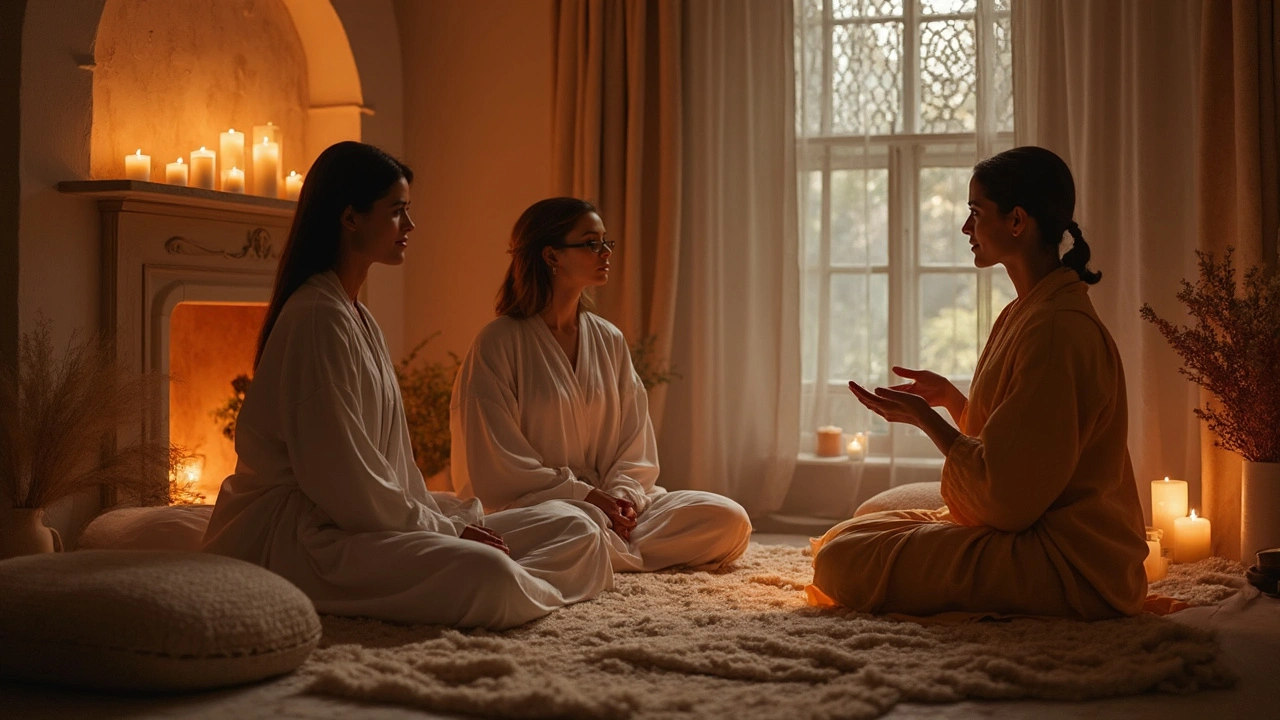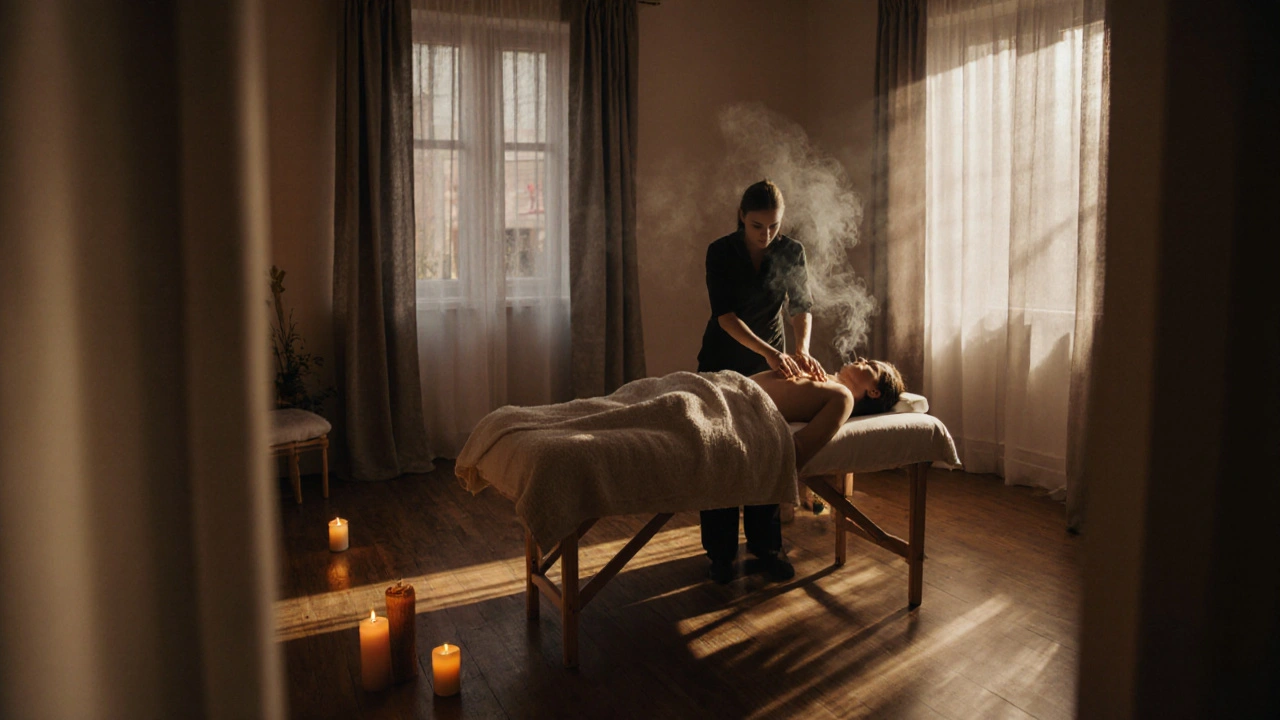Tantra massage isn’t just about relaxing—it’s about tuning in to yourself in a whole new way. If you thought massage was only about knots and tension, tantra adds a deeper layer. Different styles suit different needs: some people want healing, others go for energy, and a lot just want to feel more comfortable in their own skin. Whatever your reason, there’s a type of tantra massage built for you.
Ever felt awkward not knowing what style is right, or what each session includes? You’re not alone. Picking a style isn’t just about price or hype. The techniques, atmosphere, and goals all play a part. Before booking, it’s smart to know what makes each version stand out, what you’ll experience, and how it might leave you feeling afterward.
- Key Points
- Definition and Context
- Types of Tantra Massage
- What to Expect During a Session
- Benefits and Tips
Key Points
If you're curious about tantra massage, knowing the core facts makes everything easier. Here are the details that matter most:
- Tantra massage comes in several styles—they aren’t all the same. Some focus on energy flow and breathing, while others add traditional bodywork or use oils for deeper relaxation.
- Most sessions mix in elements you might not expect, like guided breathing, meditation, or even sound. It’s not just a physical rubdown. The idea is to connect body, mind, and emotion.
- Each style has its own routine. Some start out fully clothed, others encourage partial or full nudity, always focusing on boundaries and consent first. Communication with your therapist before and during your session is key.
- People choose tantra massage for many reasons: stress relief, self-discovery, better intimacy, trauma healing, or simply as a different way to unwind after a tough week.
- First-timers are often surprised by the slow pace and the amount of focus on breath and subtle sensation—don’t expect a quick fix or a classic spa vibe here.
| Tantra Massage Style | Main Focus | Typical Length |
|---|---|---|
| Traditional Tantra | Energy, breathing, meditation | 90-150 minutes |
| Neo-Tantra | Sensuality, touch, connection | 60-120 minutes |
| Therapeutic Tantra | Stress, trauma release | 60-90 minutes |
Bottom line? This isn’t your run-of-the-mill massage. Take time to read up on each style, and don’t be shy about asking questions before booking a session. Trust and comfort always come first.
Definition and Context
Let’s clear up what tantra massage actually is, because there are a lot of myths floating around. At its core, tantra massage is about connecting mind, body, and energy. It blends ancient tantra massage techniques—with roots going back more than 2,000 years in India—with modern ideas of relaxation and healing. The point isn’t just stress relief, but to wake up your senses and build a better connection with your body.
Unlike typical massages where the goal is to loosen muscles, tantra works with breath, touch, and sometimes even guided meditation. Expect more than just physical touch—it’s also about mindful awareness, energy flow, and emotional release. People use tantra massage for loads of reasons: improving intimacy, easing anxiety, or just learning to relax in a new way.
Here’s how it differs from other common massages:
| Type | Focus | Typical Duration | Unique Element |
|---|---|---|---|
| Tantra Massage | Energy, mind-body connection | 60-120 min | Breathwork, mindful touch |
| Swedish Massage | Muscle relaxation | 60-90 min | Gentle, flowing strokes |
| Deep Tissue Massage | Relieving muscle pain | 60-90 min | Firm pressure, focused work |
Tantra massage isn’t done in chains or big spas—you usually find it in private studios or with therapists trained in specific tantra methods. Qualifications can vary a lot, so always ask about a therapist’s background, especially if you’re new to it.
People sometimes wonder if tantra must mean something sexual. The answer depends on the style and your personal boundaries. Some forms are deeply spiritual and stay fully clothed, while others include elements meant for adults. Always talk it through with your therapist before a session.

Types of Tantra Massage
Here’s where things get interesting. There’s no single way to experience tantra massage—think of it like picking your favorite dish at a buffet. Each type brings its own approach, tools, and even energy. Let’s break down the most common styles you’re likely to come across, so you know what you’re signing up for.
- Traditional Tantra Massage: This style goes back to ancient practices from India and uses slow, mindful touch to awaken energy throughout the body. The idea is to unblock energy points, called chakras, and help you feel more in tune with yourself. You’ll usually be guided to focus on your breath, letting go of tension while the therapist uses long, full-body strokes. If you’re after an authentic experience with roots in Eastern traditions, this is your starting point.
- Neo-Tantra Massage: Neo-tantra puts a modern spin on the classics. It adds in elements from Western bodywork, sometimes mixing Swedish or deep tissue techniques with tantric breathing and awareness exercises. This one often feels a little more casual and less ritualistic, making it a go-to for first-timers who want to dip their toes in without too much ceremony.
- Yoni and Lingam Massage: These are gender-focused techniques. 'Yoni' is for people with vulvas, 'lingam' for those with penises. Both center around sexual healing, releasing shame, and helping people reconnect with their own bodies. The session is always handled with consent and sensitivity—these massages are never about quick fixes, but instead go deep into emotional and physical well-being.
- Kashmir Shaivism Massage: If you’re curious about feeling totally present, this one is worth a look. It comes from the Kashmir region of India and emphasizes slow, synchronized movements while both the giver and receiver focus on shared energy and presence. There’s less emphasis on erotic energy and more on spiritual connection and calm.
- Couples Tantra Massage: Want to give or receive a massage with a partner? This style focuses on connection and trust between two people. Some sessions teach you techniques to use at home, while others guide both of you through the process side by side. It’s pretty popular for folks wanting to deepen intimacy or simply learn new ways to relax together.
While each style has its own spin, the main goal is the same: you leave feeling more aware, more relaxed, and just a little more yourself. When booking, ask upfront which tantra massage styles a therapist specializes in—no sense paying for a session that doesn’t match your vibe or comfort level. And remember, if you ever feel unsure, speak up. Trust and safety aren’t optional—they’re the foundation of any good session.
What to Expect During a Session
Walking into a tantra massage session can feel like a leap into the unknown, but the flow is designed to help you settle in fast. Most places ask you to arrive a few minutes early, so you have time to relax, fill out an intake form, and talk to your practitioner about what you want from the session—this could be stress relief, energy work, or just curiosity about the tantra massage approach.
After chatting, you’ll get a quiet space to change or undress to your comfort level. Don’t worry—boundaries, privacy, and consent are huge priorities. The therapist checks in constantly, making sure you’re always on board with what’s happening. If something feels off, speak up—there’s no judgment here.
The massage itself usually starts with gentle breathing or grounding exercises. This isn’t just about muscles; many styles focus on slow touches, long strokes, and tuned-in rhythm. Expect a lot of focus on energy flow—some therapists use specific hand placements or light pressure to work with the body’s natural energy lines. Oils or lotions are often used, and the room will probably be set with soft lighting and calming music for total relaxation.
During the session, it’s normal to notice strong physical and emotional reactions. People often feel relaxed, sometimes a little emotional, or notice an energy shift in their bodies. Communication is key: Your feedback usually shapes the session as it goes.
Right after the massage, there’s usually a cool-down—some quiet time to let your body and mind settle. You might chat with the therapist about what you felt or get tips for integrating the experience into daily life. Most people leave feeling settled, sometimes surprised, and usually a little more connected to themselves than when they walked in.
- Arrive early for an easy start
- Set your boundaries and goals up front
- Breathing or body awareness kicks things off
- Techniques focus on energy, not just muscles
- Aftercare includes reflection and rehydration—drink water!

Benefits and Tips
If you’re on the fence about tantra massage, real talk—there’s more happening than just relaxation. People try tantra massage for everything from stress relief to a boost in body confidence. Your mind and body both get something out of it, and sometimes the effects stick around longer than a standard deep tissue massage.
Here’s what you’ll actually get from a good tantra massage session:
- Stress Reduction: Many people leave a session feeling lighter, less anxious, and way more at ease. It’s like someone turned down the volume on your day-to-day worries.
- Energy Boost: Some styles wake up your whole system. It’s not just a nap—it’s feeling recharged and clear-headed later, and some folks report an increased zest for days afterward.
- Better Sleep: One UK wellness survey found that over 60% of people who tried tantra massage noticed better sleep within a week of their first try. It calms your body so you rest easier.
- Improved Body Awareness: Because tantra massage is all about tuning in, lots of regulars say they’re more comfortable in their skin and have a better sense of what their body needs.
- Relationship Perks: Couples who try partnered sessions often say they communicate better and feel more connected after. Not magic, just more awareness and comfort with each other.
Check this quick table for some stats and highlights:
| Benefit | Reported by (%)* | Time To Notice |
|---|---|---|
| Reduced Stress | 75% | Immediately to 1 day |
| Improved Sleep | 63% | Within 1 week |
| Boosted Body Confidence | 48% | After 2-3 sessions |
| More Energy | 52% | 1-2 days |
*Based on a 2023 survey of adults who received various types of tantra massage in London and New York.
Alright, considering a session? Here are some user-friendly tips to get the best results:
- Ask questions before you book. Not all therapists do every style, and clear communication helps everyone feel comfortable.
- Don’t rush right after your massage—schedule some wind-down time to soak up the benefits.
- Let your therapist know if you’re nervous or new. They’ll usually walk you through what’s going to happen so you don’t go in blind.
- Clothing varies—some sessions are fully clothed, some aren’t. Check ahead so you know what the setup is and can relax.
- Hydrate before and after. Tantra massage can leave you thirsty, sort of like a workout (just without the sweat).
Most important, if you’re looking for something more than just muscle relaxation—like a kickstart for your mind, mood, or relationship—tantra massage might be worth trying. Just remember, every experience is personal, so try a style or two and see what works for you.




